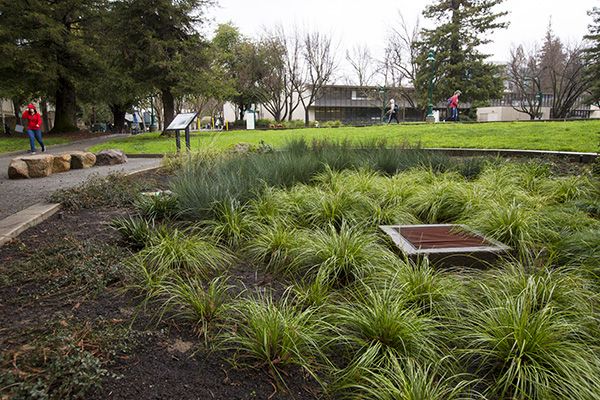Innovative Stormwater Project Nurtures the American River
Published on by Water Network Research, Official research team of The Water Network in Technology
Sacramento State’s award-winning stormwater-management project is cleverly disguised as tidy gardens sprouting drought-tolerant plants and porous walkways made of crunchy-looking concrete.

A maturing rain garden and porous pavement in the Library Green are among the many campus stormwater-management devices that ensure clean water runs into the American River. (Sacramento State/Jessica Vernone )
The 24 LID (low-impact development) devices in seven campus locations collect and filter 2.9 million gallons of stormwater each year, greatly reducing the University’s impact on the neighboring American River. Sediment and metal loads flowing into the river from those seven locations are down 60 percent to 90 percent on average.
“The whole project is about protecting the American River,” says Maureen Kerner, research engineer with Sacramento State’s Office of Water Programs (OWP). “Before this project, stormwater runoff on campus was collected and pumped over the levee directly into the river, carrying pollutants with it.”
Sac State is protecting the river’s many beneficial uses, including Sacramento’s municipal water supply, the aquatic habitat, and recreational boating, swimming, and fishing.
In 2014, the state Water Resources Control Board awarded OWP and the City of Sacramento $2.6 million in Proposition 84 clean-water funds to design, build, and monitor the LID project. Sacramento State added $500,000 in matching funds, and the City of Sacramento contributed another $112,000. Construction began in June 2015.
Today, the system of innovative LID devices – bioretention planters, a flow-through planter, rain gardens, an infiltrating bioswale, roof downspout disconnects, and porous pavement – is functioning as planned. In addition to reducing stormwater runoff into the river and preventing erosion, the devices replenish campus groundwater supplies that are used for irrigation.
“You will see many more devices pop up around campus as the University implements its Master Plan to expand green-space connectivity and better manage stormwater through more aesthetic and sustainable practices,” Kerner says.
Plans include installing stormwater planters and a dry well near Parking Structure V, which will be built on the site of the current Parking Lot 1. The dry well will include a pretreatment vault where pollutants will settle before the runoff is directed into a 20-foot subsurface well to recharge the groundwater.
“The LID project has gone a long way in promoting the use of sustainable stormwater practices locally and regionally,” Kerner says. “Several other colleges and universities are mimicking our project and installing stormwater planters and porous pavement.”
Read more: Sacramento State
Media
Taxonomy
- Urban Drainage
- Technology
- Stormwater Management
- Pollution
- Stormwater
- Urban Water
- River Restoration
- Storm Water Management